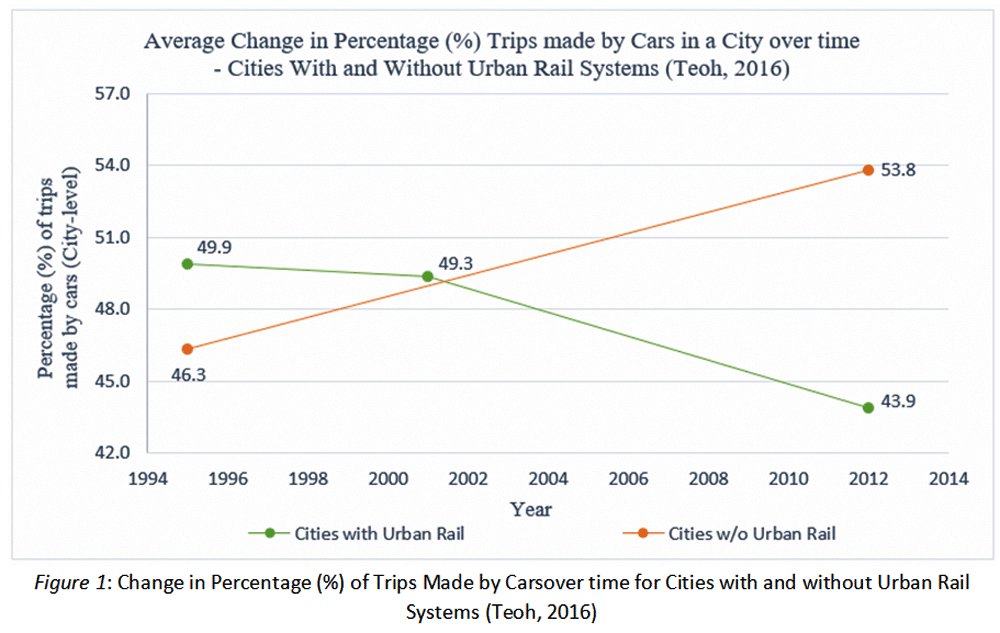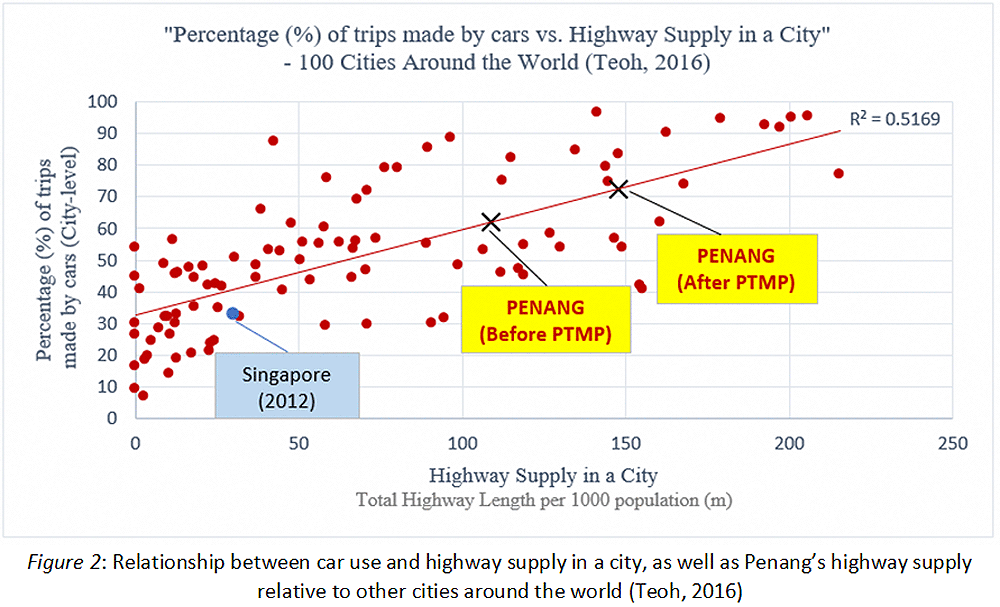This article aims to use simple graphics and statistics to provide a clearer picture by quantifying the consequences of the Penang Transport Master Plan (PTMP) as proposed by the Penang state government.
In general, a global cities database containing key transport statistics from 100 cities around the world is supplied by Transport for London (TfL) and used to conduct this analysis. By analysing and understanding this database, the future mobility options and transport patterns for Penang can be reliably estimated.
Penang needs more LRT lines
In my previous article, I highlighted the need for an increased emphasis and investment towards LRT systems in Penang. According to the global cities database, it is crucial for a city to have a good urban rail network in order to reduce car use and traffic congestion.
Figure 1 below provides a clear evidence, showing that cities with a form of urban rail system (trams, LRT or metro) reduced their car use on average between 1995 and 2012. Conversely, cities without any urban rail system in place experienced the opposite effect of increasing car use and dependence.

At the present day, Penang sadly does not have any urban rail systems in place, which reflects the phenomenon of a continued increase in car use and road traffic growth in the state. Although one might highlight that the PTMP already proposes a 17.5km Penang International Airport-Komtar LRT route, having only one LRT line is not enough to make it a feasible alternative to the car.
While I acknowledge that the Penang state government has emphasised the need to develop both roads and urban rail systems at the same time, the next section provides evidence to demonstrate why this is not feasible.
The need to scale back on highways
Figure 2 below shows the very strong relationship between car use and highway supply. It is clear that car use and dependence in a city increases together with highway supply regardless of public transport improvements. In other words, if a city builds more highways, travellers will spontaneously increase their car use due to convenience.

At the present day, even before the new highways are constructed, Penang already has a high freeway supply relative to other cities around the world (figure 2). Based on calculations, the proposals from the PTMP will further increase highway supply from 108.1 to 148.1 metres per 1,000 people, which car use and dependence in Penang is expected to increase to unsustainable levels.
The case in favour of highway building in Penang was once referred to Singapore’s ambition in building more highways. However, this comparison to justify the case for even more highway constructions in Penang is misleading as Singapore’s highway supply on a per capita basis is around three times lower than Penang, at around 30 metres per 1,000 people (figure 2).
In this scenario of an excessive highway construction as proposed by the PTMP, it is expected that roads will still be congested regardless of public transport improvements. This can be explained with the concept of ‘induced demand’, which is also the main reason why academics unanimously reject the PTMP’s excessive highway construction.
For example, it is true that some travellers will decide to switch from cars to LRT once the system is operational, which subsequently cause roads to become less congested and comfortable to other users. However, this convenience and reduction in congestion in turn encourages other drivers back to the roads, as well as increasing their frequency of driving until the roads are congested again.
Based on this explanation, it is clear that the PTMP cannot prioritise in both road and rail developments at the same time, where road traffic will continue to grow until it reaches capacity before shifting growth towards rail and public transport. It will be implausible for the Penang state government to assume that Penangites will get off their cars and automatically reduce traffic congestion once the first LRT line is constructed.
To make matters worse, the unintended consequences of parking limitations in dense urban areas as a direct result of the excessive highway consequences was still not addressed by the Penang state government. These concerns were highlighted and explained in my first article two weeks ago and still awaiting a response.
What does the future hold for Penang?
In order to answer this question above, a statistical model is created to estimate Penang’s modal split in 2022 for two different scenarios. This statistical model is calibrated using the database provided by Transport for London (TfL) containing transport data from 100 cities around the world.
Based on the current PTMP plan, Penang’s car modal share is expected to increase from around 82 to 86 percent in 2022 (figure 3). At the same time, public transport is projected to reduce from 18 to 14 percent, which is well below the Penang state government’s target of achieving a 40 percent public transport modal share by 2030.

On the other hand, an alternative scenario of constructing more LRT lines and limiting highway construction shows that car modal share will be reduced by around 5 percent (from 82 to 77 percent), while increasing public transport usage to 23 percent in 2022. Although the reduction in car use in the alternative scenario is not huge, it provides a positive starting point of moving Penang towards the right direction in increasing public transport usage.
Surprisingly, the predictions made by this statistical model (82 percent of car use in 2015) is in close agreement with the Halcrow Report, which stated an 89 percent car use in Penang for 2012. Most importantly, the Halcrow Report also correctly pointed out that a 40 percent public transport modal share by 2030 was inconceivable, indicating that a 20 percent public transport share was more realistic.
Next, how does Penang’s degree of car use compare relative to other cities around the world? According to data released by the Land Transport Commission (Spad), Kuala Lumpur’s car modal share is at around 85 percent in 2010 with early indicators of a small reduction. Similarly, European city’s average car modal share during its peak in 2001 was around 51 percent, which this figure had since then dropped to around 45 percent in 2012.
In conclusion, these are strong indicators for Penang to scale back on highway constructions. The quantitative evidence is clear where most cities around the world is redistributing its investments towards rail-based transport. To make matters worse, modelling results from this article proved that the Penang state government is in contradiction against its own motto of ‘Moving People Not Cars’.
Governments in the developed world are increasingly adopting an evidence-based approach to formulate the right policies. It is still not too late for the state to re-evaluate the PTMP, which we can work together in attempt to achieve the goal of 40 percent public transport use by 2030. Although achieving this target will be difficult, it is not an insurmountable task as long as the right policies are formulated.
References
Teoh, R (2016) Applications and Barriers of Increasing Sustainable Transport Modes in Car Dependent Cities. MSc Transport Engineering. Imperial College London.
Detailed analysis and calculations can be made available upon request via e-mail, at [email protected]
ROGER TEOH is a postgraduate student studying for a PhD at the Centre for Transport Studies, Imperial College London.

